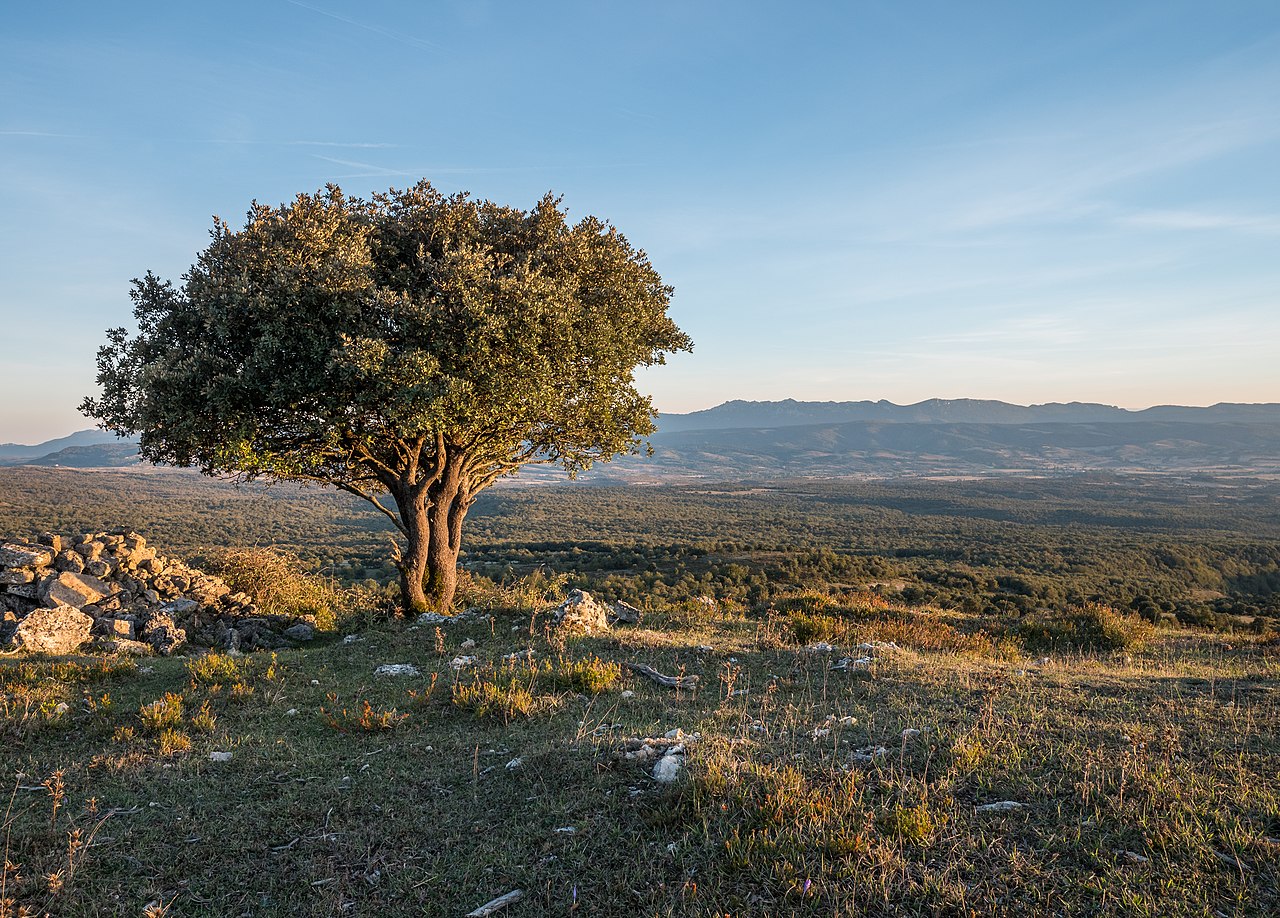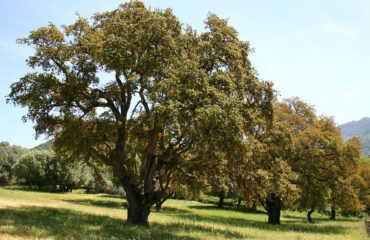Quercus ilex, commonly known as the Holm Oak or Evergreen Oak, is a robust, evergreen tree native to the Mediterranean region. Renowned for its dense canopy, leathery leaves, and resilience to drought and poor soils, the Holm Oak is widely used in landscaping, forestry, and ecological restoration. It plays a crucial role in Mediterranean ecosystems, providing habitat and food for wildlife. Propagating Quercus ilex can be achieved through various methods, including seed propagation, cutting propagation, grafting, and layering. Each method has unique benefits, from promoting genetic diversity to preserving specific cultivars with desirable traits.
Quercus ilex (Holm Oak) Propagation Methods
This comprehensive guide outlines Quercus ilex propagation methods, providing practical insights for both novice and experienced horticulturists to foster and expand their appreciation of this resilient and valuable Mediterranean evergreen species.
1. Seed Propagation
1.1. Seed Collection
Seed propagation is a straightforward and natural method for producing Holm Oak trees, allowing for genetic diversity.
- Identifying Mature Acorns: Holm Oak seeds are encased in acorns that mature in late summer to early autumn. Mature acorns are typically brown and easily detach from the tree or fall naturally.
- Collecting Acorns: Gather acorns from the ground beneath the tree or directly from the branches. Select healthy, plump acorns free from visible damage or pest infestations.
1.2. Seed Preparation
Proper seed preparation improves germination rates and seedling vigor.
- Cleaning and Sorting: Remove the caps from acorns and soak them in water for 24 hours. Discard any acorns that float, as they are likely non-viable.
- Stratification: Cold stratification helps break seed dormancy. Place acorns in a moist medium like sand or peat moss and refrigerate at 2-4°C (36-39°F) for 1-3 months to mimic winter conditions.
1.3. Sowing and Germination
After stratification, acorns are ready for sowing.
- Sowing Acorns: Plant acorns horizontally or with the pointed end slightly downward in a well-draining, sandy soil mix. Cover them lightly with soil.
- Germination Environment: Place seed trays in a bright area with indirect sunlight. Maintain a temperature of 15-20°C (59-68°F) and keep the soil consistently moist but not waterlogged.
- Care for Seedlings: Germination typically occurs within 2-3 weeks. Provide seedlings with bright, indirect light and regular watering. Transplant seedlings into individual pots once they develop a strong root system and several true leaves.
2. Cutting Propagation
2.1. Selecting and Preparing Cuttings
Cutting propagation allows for cloning specific Holm Oak cultivars, preserving desired traits.
- Choosing Cuttings: Select healthy, semi-hardwood shoots from the current year’s growth. The best time to take cuttings is in late summer to early autumn.
- Preparing Cuttings: Cut 10-15 cm (4-6 inches) sections from shoots just below a node. Remove lower leaves to expose the stem for rooting.
2.2. Rooting Hormones and Planting
Using rooting hormones can enhance the success rate of cuttings by promoting root development.
- Applying Rooting Hormone: Dip the base of each cutting in rooting hormone powder or gel to stimulate root formation.
- Planting Cuttings: Insert treated cuttings into a well-draining rooting medium such as a mix of peat and perlite or sand. Ensure the medium is moist and sterile to prevent fungal infections.
2.3. Rooting Environment and Care
Creating an optimal rooting environment is crucial for successful cutting propagation.
- Maintaining Humidity: Use a humidity dome or plastic cover to maintain a moist environment around the cuttings, reducing water loss through transpiration.
- Optimal Conditions: Place cuttings in a bright area with indirect light. Maintain a temperature of 18-22°C (65-72°F) and keep the medium consistently moist but not saturated.
- Monitoring Root Development: Roots typically form within 8-12 weeks. Check for root growth by gently tugging on the cuttings. Once rooted, gradually acclimate new plants to lower humidity and normal light conditions before transplanting into individual pots.
3. Grafting
3.1. Purpose of Grafting
Grafting is used to propagate specific Quercus ilex cultivars and maintain their desirable traits.
- Advantages: Grafting combines the scion’s desired traits with the rootstock’s vigor and adaptability, resulting in improved growth, disease resistance, and uniformity in the propagated trees.
3.2. Grafting Techniques
Several grafting techniques are suitable for Holm Oak.
- Scion and Rootstock Selection: Choose a healthy scion from the desired cultivar and a compatible rootstock, often another Quercus ilex or a robust oak variety that supports the scion’s growth.
- Whip and Tongue Grafting: This method involves cutting both the scion and the rootstock with slanting cuts and notches (tongues) to interlock, ensuring a strong and stable graft union.
- Cleft Grafting: Make a vertical cut in the rootstock and insert the wedge-shaped scion into the cleft, ensuring that the cambium layers align.
3.3. Post-Grafting Care
Proper post-grafting care is essential for graft union success and the health of the grafted plant.
- Securing the Graft: Use grafting tape or wax to secure the graft union, preventing drying and physical damage.
- Healing Environment: Place grafted plants in a controlled environment with high humidity and stable temperatures to promote healing and growth.
- Monitoring and Maintenance: Regularly check the graft for signs of success or failure. Once established, gradually acclimate the plant to outdoor conditions. Remove any shoots from the rootstock to ensure all growth is from the scion.
4. Layering
4.1. Purpose of Layering
Layering is a reliable method for propagating Holm Oak, especially when propagating from mature trees or specific cultivars.
- Benefits: This method has a high success rate and causes minimal disturbance to the parent plant, making it suitable for species that are difficult to propagate by cuttings.
4.2. Layering Techniques
Both ground and air layering can be used effectively for Quercus ilex.
- Ground Layering: Select a low-growing branch and bend it down to the soil. Make a small cut or remove a ring of bark where the branch touches the soil to expose the cambium. Secure the branch in a shallow trench with a peg or stone and cover it with soil, leaving the tip exposed.
- Air Layering: Choose a healthy branch, make a small cut or remove a bark ring to expose the cambium. Apply rooting hormone, wrap the exposed area with moist sphagnum moss, and cover it with plastic wrap to retain moisture. Secure with ties or tape.
4.3. Post-Layering Care
Ensuring proper care during and after the layering process is crucial for success.
- Maintaining Moisture: Keep the buried or wrapped area moist throughout the rooting period. For air layering, ensure the moss remains damp but not waterlogged.
- Monitoring Root Development: Check for root growth periodically. Ground layers typically root within 6-12 months, while air layers may take longer.
- Separating and Transplanting: Once a strong root system has developed, carefully cut the new plant from the parent. Transplant it into a pot or directly into the ground. Provide adequate water and care to help the new plant establish itself.
Conclusion
Propagating Quercus ilex through seeds, cuttings, grafting, or layering provides various methods for cultivating this versatile and ecologically significant Holm Oak. Seed propagation promotes genetic diversity and natural regeneration. Cutting propagation allows for cloning specific cultivars with desirable traits. Grafting combines the strengths of scion and rootstock for enhanced growth and resilience. Layering offers a reliable, low-disturbance method for propagation. Mastery of these techniques supports the sustainable cultivation and conservation of Holm Oak, contributing to landscape diversity, habitat restoration, and the health of Mediterranean ecosystems.


